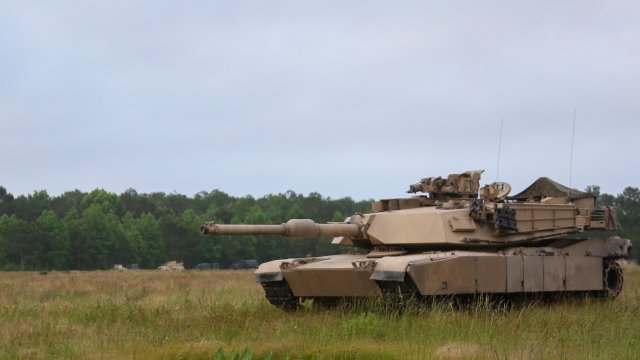| a | |||
|
|
|||
|
Defence & Security Industry News - DRS Technologies
|
|||
|
|
|||
|
USMC plans to test Trophy active protection system on its M1A1 tanks
|
|||
|
The United States Marine Corps (USMC) plans to buy or lease existing active protection systems (APS) for its M1 Abrams tanks that are vulnerable to proliferating anti-tank guided missiles, the US-based companay DRS Technologies unveiled on its website on April 14.
|
|||
|
|
|||
 Camp Lejeune, North Carolina - An M1A1 Abrams tank with 2nd Tank Battalion, 2nd Marine Division, holds position while providing rear-guard security during an obstacle-breaching exercise on Marine Corps Base Camp Lejeune, N.C., May 20, 2015 Camp Lejeune, North Carolina - An M1A1 Abrams tank with 2nd Tank Battalion, 2nd Marine Division, holds position while providing rear-guard security during an obstacle-breaching exercise on Marine Corps Base Camp Lejeune, N.C., May 20, 2015(Credit: US Marine Corps) |
|||
|
|
|||
|
Specifically, the Marine Corps will test the Trophy APS system developed by Israeli defense firm RAFAEL and sold in the United States by DRS Technologies, Lt. Gen. Robert Walsh, deputy commandant of the Marine Corps for combat development and integration, told members of the Senate Armed Services subcommittee on seapower April 13.
“Working very closely with the Army to develop active protection systems, we’re going to go out and try to buy or lease some Trophy systems that are out there…and we’re going to put those on our M1A1 tanks, take that, use it, see how it works.” Walsh’s naming Trophy was the first time senior service acquisition officials from either the Marine Corps or Army have mentioned a brand-name APS technology in public. The Army’s principal deputy to the assistant secretary for acquisition, logistics and technology Lt. Gen. Michael Williamson has said the service plans on putting four systems head-to-head in impending tests. No program of record for an APS exists other than the Army’s modular active protection system (MAPS), which is a research and development effort to field a system in 10 years. Walsh echoed Army leadership in saying threats to ground vehicles are emerging faster than MAPS will field a suitable defense. “It could take us a long time to develop active protection systems on vehicles,” Walsh said. “We could be here for a long time while the threat continues to move ahead of us.” The Army plans to do the same on the Stryker and M1A2 Abrams tanks, Walsh said. Both services will test the Trophy system–and others–and “learn from that and see whether we buy that or something else,” Walsh said. “At least we’ve learned from it rather than slowly developing a technology over time,” he said. On the ground, the proliferation of anti-tank guided missiles is presenting the same threat to Marine Corps tactical vehicles that heat-seeking and man-portable air defense missiles posed to rotorcraft. Like the Army, the Marine Corps has bolted on about as much armor as possible to its tanks and other vehicles as possible without seriously degrading vehicle performance. “Just like we saw helicopters getting shot down in Iraq and Afghanistan, we’re going to have the same problem if we don’t get out in front of this technology on the ground side also,” Walsh said. “What we’ve continued to do is up-armor our capabilities on the ground, put more armor on them. We’ve got to start thinking about more of the higher technology capability with…active protective systems that can defeat anti-tank guided munitions, RPGs.” Trophy is the only APS that has been proven in combat. Israeli Merkava tanks were outfitted with the system during the 2014 Gaza conflict where they successfully destroyed incoming missile threats in highly congested urban combat, Mike O’Leary, director of advanced concepts at DRS, told Defense Daily in a recent interview. The system incorporates both soft- and hard-kill missile countermeasures. Soft-kill systems either disguise a vehicle from an incoming threat or spoof or damage its homing ability by electronic means. Hard-kill systems provide a secondary level of protection that physically destroy incoming projectiles before they reach the vehicle and ideally before detonation. Trophy also automatically identifies the direction from which a missile was fired and directs offensive systems toward the threat, O’Leary said. All of those capabilities were demonstrated in actual combat in Gaza. “Previously, you only knew there was an enemy in the area when incoming rounds started bouncing off your vehicle,” O’Leary said. Other available systems include the Iron Curtain APS developed by Virginia-based R&D firm ARTIS but originated from the Defense Advanced Research Projects Agency (DARPA). Raytheon also has developed an APS technology that includes both hard- and soft-kill missile countermeasures. Raytheon officials have said their system is ready for immediate integration and testing on tanks and tactical vehicles. Walsh said the Marine Corps should consider both hard-kill and soft-kill vehicle protection systems. “We have both hard- and soft-kill on our aircraft,” Walsh said. “We need that same type of technology on our vehicles.” Trophy has been integrated and tested on a Stryker during previous APS testing initiated by the Secretary of Defense, O’Leary said. DRS has plans in place to integrate Trophy onto M1 tanks. In 2012 and 2013, Trophy underwent live fire testing mounted on a Canadian light armored vehicle. While the baseline Trophy system remains the same, each vehicle requires unique integration to address the threats that it likely will encounter, O’Leary said. Consideration is also given to integration with a particular vehicle’s onboard electronics and power-generation suite. “In many cases the threats to a main battle tank are different than the threats to a medium armored vehicle,” he said. “What it carries, the environments it fights in, that all has to be taken into consideration. It’s not a one-size-fits-all solution.” |
|||
|
|














